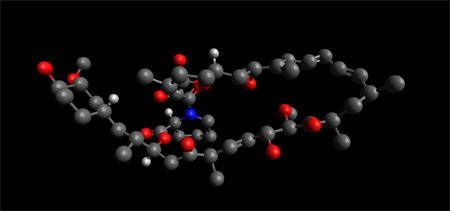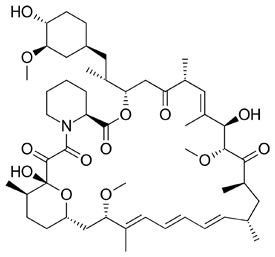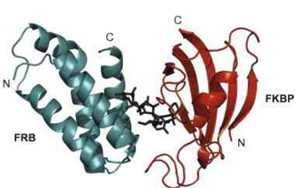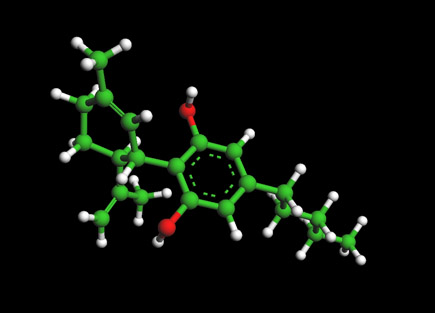Rapamycin Molecule - Sirolimus

Ball and Stick Model for Rapamycin Molecule
Rapamycin also known as Sirolimus has become one of the most talked about and researched small molecules in recent years. It is a compound that in nature is produced by the soil bacterium Streptomyces which was first found in 1965 in a soil sample from Easter Island. Rapamycin was first developed ias an antifungal agent, as it proved effective in suppressing yeast growth. However, it was soon discovered that it also acted as an immunosuppressant, and it has since been used to protect organ transplant patients from organ rejection."... More years went by, and, in 1999, rapamycin received US FDA approval as an immunosuppressant for organ transplants. A derivative was approved to treat kidney cancer in 2007. Then, in 2009, researchers at Jackson Laboratories in Maine discovered the drug’s “fountain of youth” attributes—it extended the lives of lab mice by 6 months or more..." see ref 1. Rapamycin holds the distinction of having been one of the first drugs to have its target identified biochemically: the aptly named protein “mammalian target of rapamycin,” or mTOR.[2]
Structure

Rapamycin Molecular Structure
Rapamycin is a macrolides, compounds that contain large (14–16-membered) lactone rings and reduced saccharide substituents created by bacteria. Many macrolides, such as erythromycin and azithromycin, have been formulated into commercial antibiotics [1]
Mechanism of Action as an Anti-Aging Molecule
Mammalian target of rapamycin (mTOR -- mechanistic target of rapamycin) is a kinase at a key signalling node that integrates information regarding extracellular growth factor stimulation, nutrient availability and energy supplies. Rapamycin inhibits mTOR by associating with its intracellular receptor FKBP12. The FKBP12–rapamycin complex binds directly to the FKBP12-Rapamycin Binding (FRB) domain of mTOR, inhibiting its activity.

Structure of rapamycin (A) and (B) rapamycin bound to its protein partners FKBP12 and FRB of mTOR. (PDB 1NSG [3]).
Combination Therapies using Rapamycin to slow Aging
The researchers were building on previous studies finding that lithium, trametinib and rapamycin can each extend lifespan in fruit flies (Drosophila), which is supported by other preliminary evidence in mice, worms, and cells, and observational findings in people.
The three drugs all act on different cellular signalling pathways that together form the nutrient sensing network, which is conserved across evolution from worms and flies all the way to humans. This network adjusts what the body is doing in response to changes in nutrient levels. The three drugs in question act on different proteins of this network to slow the ageing process and delay the onset of age-related death.
"...For the latest study, the researchers gave fruit flies doses of lithium, trametinib and rapamycin, separately and in combination. Each drug individually extended lifespan by an average of 11%, while pairing two drugs extended lifespan by roughly 30%. When the three drugs were combined, the fruit flies lived 48% longer than flies in a control group that were not given the treatment..." [4]
REFERENCES
1- Rapamycin -- I may have wandered into the Fountain of Youth. What molecule am I?July 25, 2016.
2- Is Rapamycin the new aspirin? December 11, 2011.
3- Protein translocation as a tool: The current rapamycin story-- July 2012.
4- A triple drug combination targeting components of the nutrient-sensing network maximizes longevity August 1, 2019
SENOLYTIC AND ANTI-AGING MOLECULES
RAPAMYCIN ---The mechanistic target of rapamycin (mTOR) pathway has a central role in cell activation...
METFORMIN -- The diabetes drug metformin used by some for anti-aging may diminish benefits of aerobic exercise...
QUERCETIN-- AND WITH DASATINIB--The senolytic cocktail, dasatinib plus quercetin, which causes selective elimination of senescent cells...
FISETIN--Of the 10 flavonoids tested, fisetin was the most potent senolytic...
EGCG- The most active component of green tea....
NAD BOOSTERS --'...The cells of the old mice were indistinguishable from the young mice, after just one week of treatment...
SULFORAPHANE-- An isothiocyanate present in cruciferous vegetables activates antioxidant and anti-inflammatory responses by ...
UROLITHIN --Metabolite of Pomegranate compound with anti-aging effects passes human trial...
MITO-Q -- A water soluble fomr of CoQ10 that has excellent absorption and high bioavailability...
HONOKIOL - A bioactive natural product derived from Magnolia Bark have demonstrated ...
CURCUMIN AND ANALOGS -Recent research is focused on the design and synthesis of curcumin analogs as antiproliferative and anti-inflammatory agents...
BERBERINE --berberine has recently been reported to expand life span in Drosophila melanogaster, and attenuate premature cellular senescence
N-ACETYL-CYSTINE (NAC)--"...pretreatment with NAC increased glutathione levels in the older cells and largely helped offset that level of cell death..."
PIPERLONGUMINE - A natural product from the Long pepper with high bioavailability...
RESVERATROL AND PTEROTSILBINE -- Pterostilben chemically similar to resveratrol bute differs from resveratrol by exhibiting increased bioavailability (80% compared to 20% in resveratrol)
SPERMIDINE--Spermidine delays aging in humans ...
ALLICIN -- Allicin is a compound produced when garlic is crushed or chopped. ...
VITAMIN D3 -- Production of the active forms of Vitamin D are reduced by 50% as a result of an age-related decline
VITAMIN K-- evidence suggests vitamin K has an anti-inflammatory action
TOCOTRIENOL(AND WITH QUERCETIN) --Tocotrieniols have been found to exert a synergistic antitumor effect on cancer cells when given in combination....
HSP-90 INHIBITORS --As a novel class of senolytics
World of Molecules Resources
The Cannabidiol Molecule
Cannabidiol (CBD is the major non-psychoactive component of Cannabis and is being looked at by major drug and consumer companies for various medical and social uses.